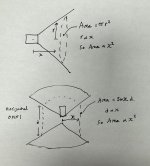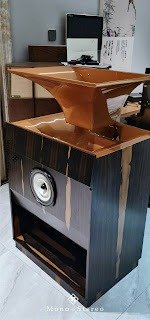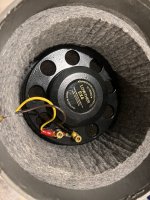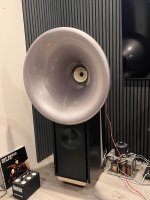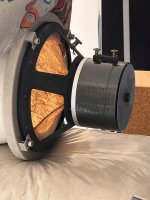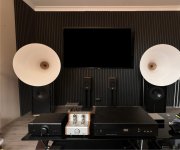I heard these at the recent Southwest Audio Fest. Semrad Audio. I wasn't sure what to expect, but wow. They amazed in many ways playing Blue Note jazz records primarily. I asked for some classical and they also impressed on piano. I had my son with me with hearing up to 19 Khz and he didn't detect bothersome colorations or problematic high frequencies. I had brought him to the Zsu audio room and he (as he should have) found them terribly colored. He also felt the Borresen speakers had excessive highs, this consistent with measurements that I have seen. The horns are a JMLC curve. The drivers are Oleg Rullit’s Super Aero 8" field coil drivers.

Bill
Bill
Member
Joined 2009
Paid Member
Those horns look great, the JMLC profile, from what I've read, offers low distortion with minimum mouth-induced issues. They sure aren't small.
The right-hand speaker seems to be back-lit, that corner of the room has a standing light and it appears to be shining through the cone. So this is an open back front-loaded horn.
This driver also has a straight edged whizzer, but no 'bullet'.
Do you recall anything about the high frequency dispersion when you were in the room with them ?

The right-hand speaker seems to be back-lit, that corner of the room has a standing light and it appears to be shining through the cone. So this is an open back front-loaded horn.
This driver also has a straight edged whizzer, but no 'bullet'.
Do you recall anything about the high frequency dispersion when you were in the room with them ?
Last edited by a moderator:
Yes, the cones are translucent. Pretty wild. Because of the size of the cone and whizzer and as JMLC horns beam, I expected significant changes when I got out of the prime seat and stood to the side. I am not sure why, but it didn't bother me; the music was still simply "there" (maybe there wasn't a lot of highs in either location?). They were ridiculously dynamic and full of tone. Horns, drum hits, etc. were almost startlingly "real." I am not sure I want to see the FR, off-axis curves, or waterfall plots (only because they might make me question my sanity), but damn they sounded good.
Bill
Bill
Member
Joined 2009
Paid Member
Very nice - when are you taking delivery of a set of these horns ? 🙂
Ok, going back to a comment earlier about a corner loaded horn, the Lowther Audiovector, with the driver firing upwards so that it's a kind of reflector/waveguide arrangement. This is the opposite to what I proposed above, where I design the waveguide to minimize the interaction between whizzer cone and horn walls by keeping the horn shallow and wide.
What about a waveguide where the geometry has the driver facing into the walls of the waveguide, like the Audiovector ?
(my sketch drawing is just to show that I can still use a simple conical shape for a horizontal omni waveguide and have the same expansion rate as the more familiar conical straight horn)
So, here the whizzer is now definitely interacting with the walls of the horn.
Ok, going back to a comment earlier about a corner loaded horn, the Lowther Audiovector, with the driver firing upwards so that it's a kind of reflector/waveguide arrangement. This is the opposite to what I proposed above, where I design the waveguide to minimize the interaction between whizzer cone and horn walls by keeping the horn shallow and wide.
What about a waveguide where the geometry has the driver facing into the walls of the waveguide, like the Audiovector ?
(my sketch drawing is just to show that I can still use a simple conical shape for a horizontal omni waveguide and have the same expansion rate as the more familiar conical straight horn)
So, here the whizzer is now definitely interacting with the walls of the horn.
Attachments
Last edited:
Hi @Bigun,
i was curious to test the Sonido SFR200A with the waveguide, here it is

measurement about 10 - 15 degree off axis with miniDSP 2X4 HD PEQ - the bad breakup at 5 kHz is gone with a bit of off axis measurement
crossover 250 Hz BW4 between 21 inch OB SW and Sonido SFR200A with 8 inch to 18 inch tractrix waveguide

especially a low listening levels like today in the late evening i am surprised how good it works, very good soundstage and even nice treble, much better than expected
i was curious to test the Sonido SFR200A with the waveguide, here it is
measurement about 10 - 15 degree off axis with miniDSP 2X4 HD PEQ - the bad breakup at 5 kHz is gone with a bit of off axis measurement
crossover 250 Hz BW4 between 21 inch OB SW and Sonido SFR200A with 8 inch to 18 inch tractrix waveguide
especially a low listening levels like today in the late evening i am surprised how good it works, very good soundstage and even nice treble, much better than expected
Member
Joined 2009
Paid Member
I have rechecked the off axis degree position of the microphone it is already about 30 degrees and not 10 - 15
i let you know as soon as i can retake the measurement with 45 degrees
in the meantime it might be good to know that since i am using ROON i linearize with the CLIO Pocket at the first stage with miniDSP and in a second step at the listening position with my ears with the ROON DSP, this are the screenshots

it is also crucial to match closely the speaker setup to the listening position with the left speaker much closer to the home office desk than the right one

hope it helps,
Stefano
i let you know as soon as i can retake the measurement with 45 degrees
in the meantime it might be good to know that since i am using ROON i linearize with the CLIO Pocket at the first stage with miniDSP and in a second step at the listening position with my ears with the ROON DSP, this are the screenshots
it is also crucial to match closely the speaker setup to the listening position with the left speaker much closer to the home office desk than the right one
hope it helps,
Stefano
Last edited:
Member
Joined 2009
Paid Member
that's quite a sophisticated set up that you have, very handy for this hobby!
that parametric EQ curve does look, subjectively, like many people's preference - the fabled BBC dip is often quoted but I think there's too much confusion over that specific one, there are plenty of other studies that show how we are sensitized to the range of frequencies where you have put a dip in response.
that parametric EQ curve does look, subjectively, like many people's preference - the fabled BBC dip is often quoted but I think there's too much confusion over that specific one, there are plenty of other studies that show how we are sensitized to the range of frequencies where you have put a dip in response.
Member
Joined 2009
Paid Member
I'm really enthused about the idea of using the Oblate Spheroid geometry based profile with my Lower whizzer coned driver.
I don't know if it's the best possible profile for my goals but it appears to offer some attractive features
a) better than a conical profile because the throat offers better low frequency loading to the main cone
b) trends to a conical profile away from the throat which means no sharp low-freq. cut off seen with the exponential and it's more flexible than the Tractrix in terms of combinations of mouth size, throat size and length
c) directivity similar to conical so less beaming than a Tractrix
d) it can be shallow, allowing the whizzer cone to 'see' a lot of the listening space
This isn't a definitive list and I'm a leaner here but this is what I've understood from reading around.
Ia lso read that this coordinate system was investigated because it enabled simpler math, the commonly used horn equation is derived with a number of assumptions in mind and 1P waves is key. The Oblate Spheroid geometry is close to 1P over the frequencies of interest. OK, so then with this geometry we can use the common horn equation, it is already available as a default in Hornresp which makes life easier.
But I bet there are further improvements that could be made, especially at the mouth with more roll-over than Hornresp default curve includes. It isn't too hard to add a roll-over during construction of course.
I don't know if it's the best possible profile for my goals but it appears to offer some attractive features
a) better than a conical profile because the throat offers better low frequency loading to the main cone
b) trends to a conical profile away from the throat which means no sharp low-freq. cut off seen with the exponential and it's more flexible than the Tractrix in terms of combinations of mouth size, throat size and length
c) directivity similar to conical so less beaming than a Tractrix
d) it can be shallow, allowing the whizzer cone to 'see' a lot of the listening space
This isn't a definitive list and I'm a leaner here but this is what I've understood from reading around.
Ia lso read that this coordinate system was investigated because it enabled simpler math, the commonly used horn equation is derived with a number of assumptions in mind and 1P waves is key. The Oblate Spheroid geometry is close to 1P over the frequencies of interest. OK, so then with this geometry we can use the common horn equation, it is already available as a default in Hornresp which makes life easier.
But I bet there are further improvements that could be made, especially at the mouth with more roll-over than Hornresp default curve includes. It isn't too hard to add a roll-over during construction of course.
Bill Brown, you are not alone to think the Semrad horns sound fantastic! Your son was absolutely correct about the Borresen, there was an edge to the violin on classical music.
Member
Joined 2009
Paid Member
Member
Joined 2009
Paid Member
I want to make something like this, the joy is building not buying, but it serves as inspiration!
OS does well, what it's intended to do, but it will be working over a reduced band when used in this way.
Is loading a good thing here?a) better than a conical profile because the throat offers better low frequency loading to the main cone
Member
Joined 2009
Paid Member
Member
Joined 2009
Paid Member
I ran the oris with chamber but removed back panel that came with the kit. Preferred the sound this way.
Also been using rullit aero 8 fc drivers for a while now (2014) paired with azurahorn 160hz flares with rollback trimmed back slightly to make them bit more manageable size wise. On this horn combo I prefer a bit of boost on the treble to make it sound balanced to my ears. The rullits play on a higher sq level than the lowther ex4/oris combo. Horn loaded bass bins pair best with the horn loaded full rangers I’ve found. Not too fussed with narrow treble.
Also been using rullit aero 8 fc drivers for a while now (2014) paired with azurahorn 160hz flares with rollback trimmed back slightly to make them bit more manageable size wise. On this horn combo I prefer a bit of boost on the treble to make it sound balanced to my ears. The rullits play on a higher sq level than the lowther ex4/oris combo. Horn loaded bass bins pair best with the horn loaded full rangers I’ve found. Not too fussed with narrow treble.
Attachments
Member
Joined 2009
Paid Member
very nice!
I want wider treble dispersion, but I understand why narrow distortion is also a good idea.
I want wider treble dispersion, but I understand why narrow distortion is also a good idea.
- Home
- Loudspeakers
- Multi-Way
- Front loaded Horn - how does that work with whizzer cones?
